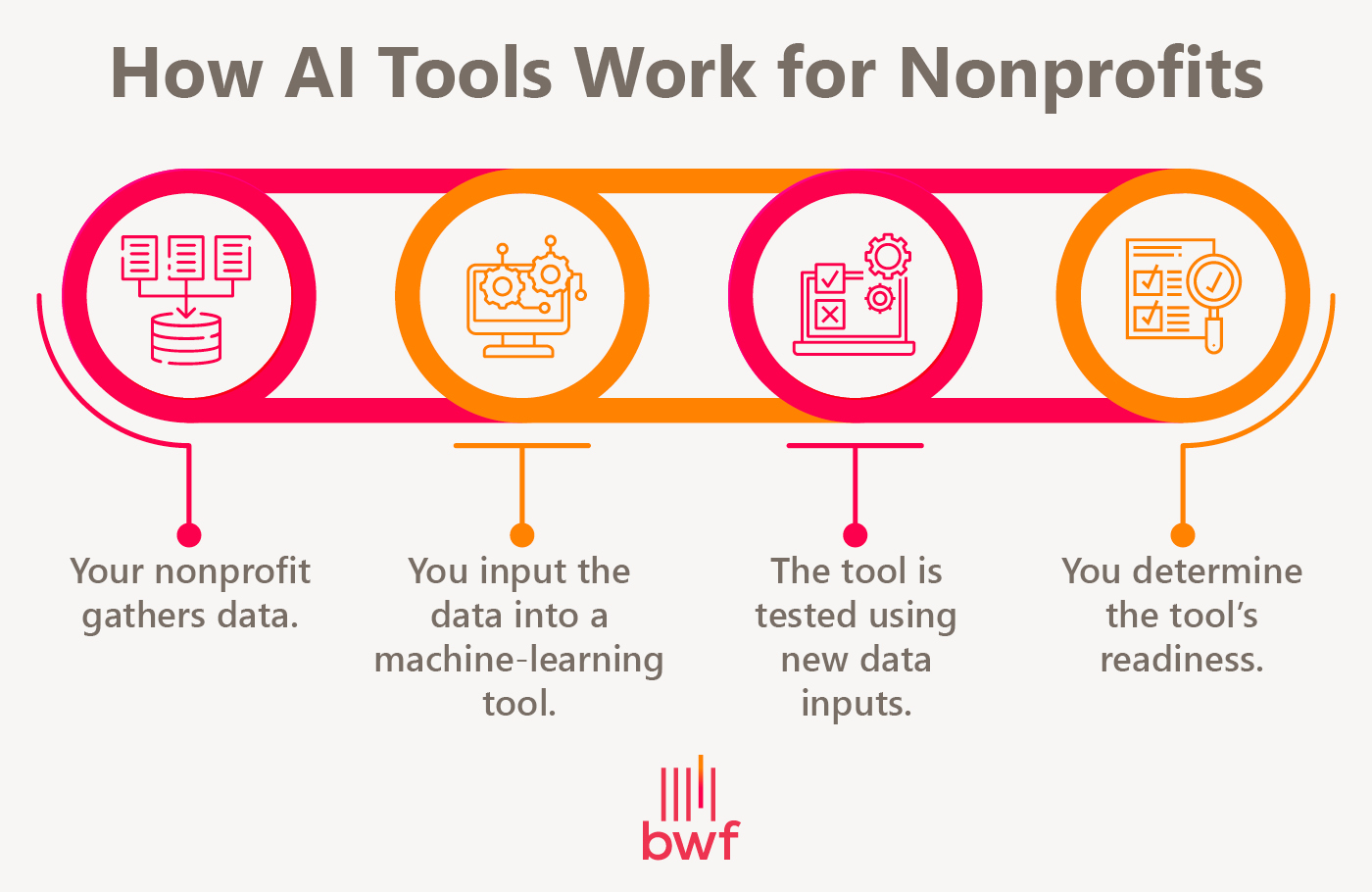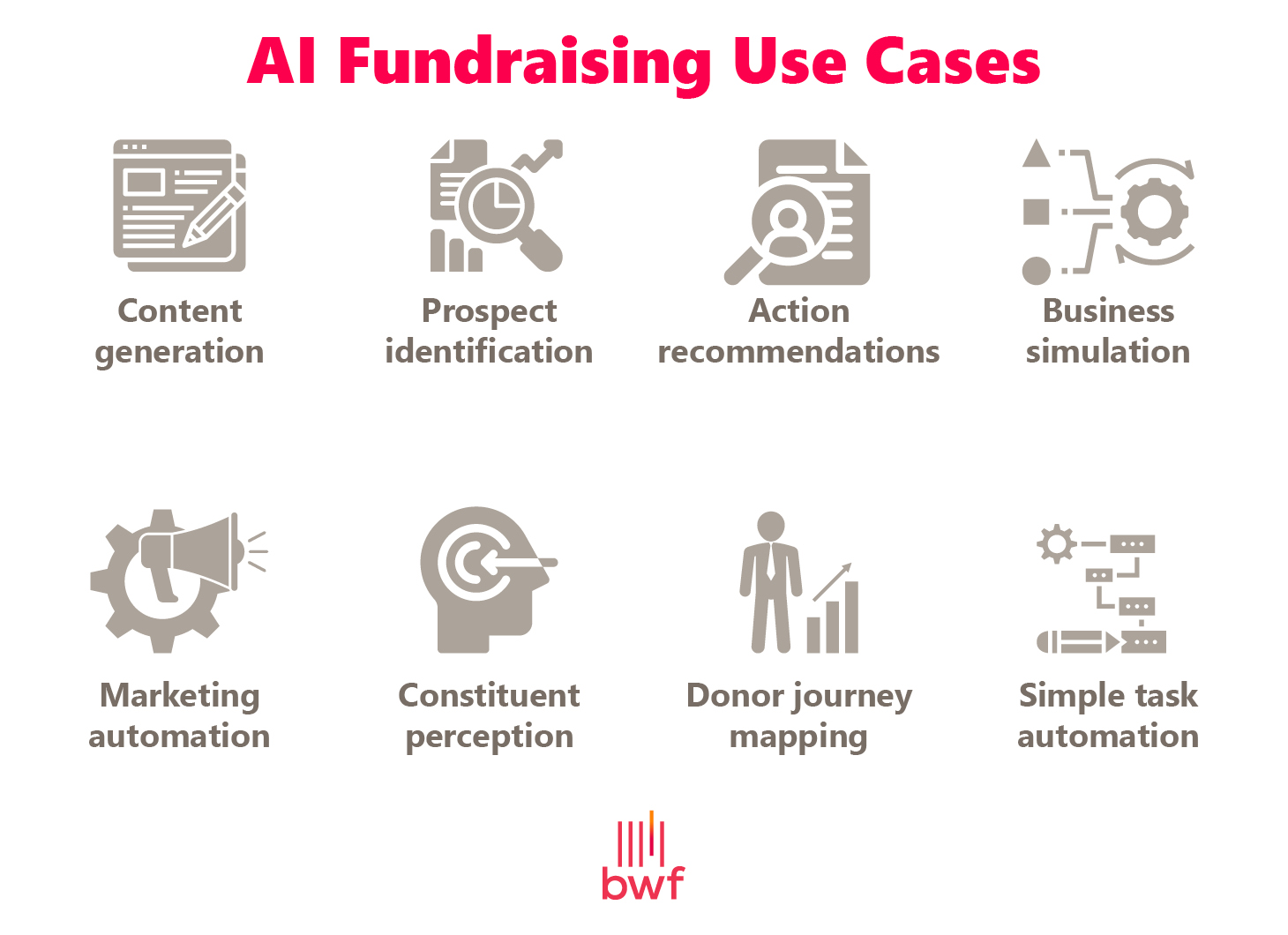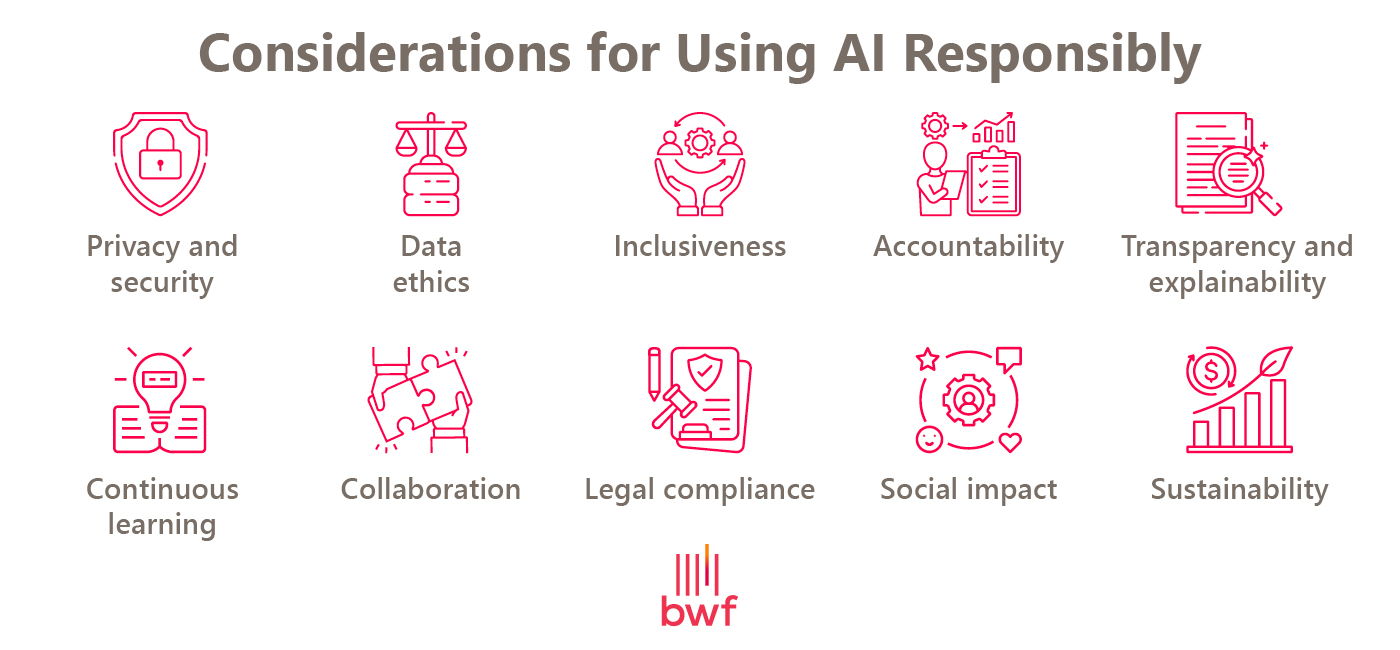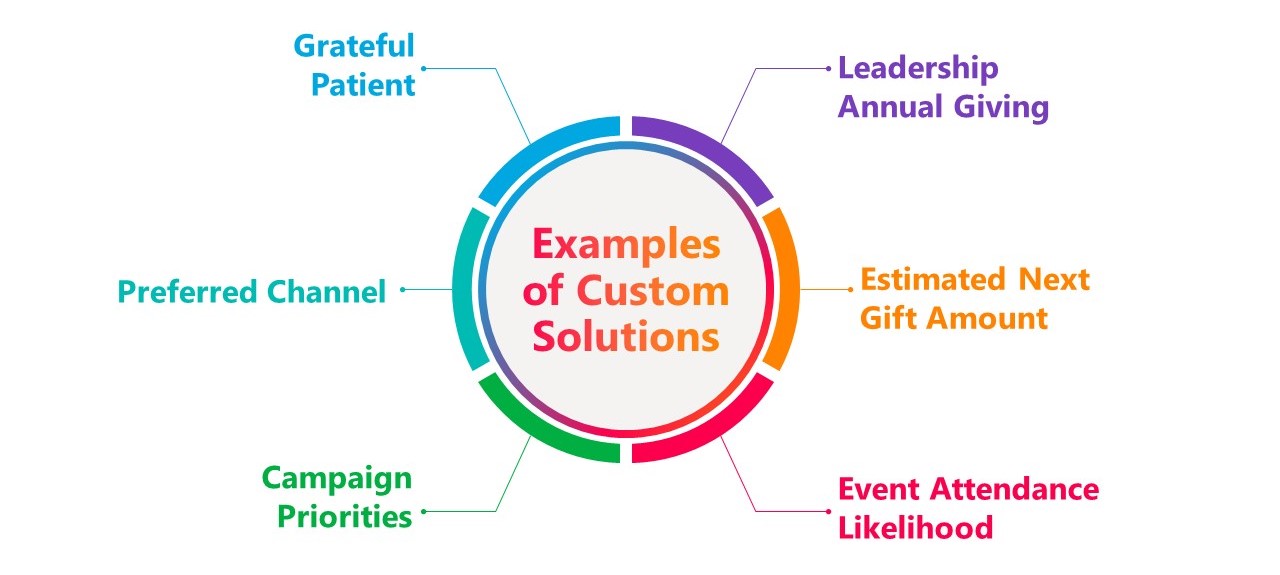The advent of the artificial intelligence (AI) era has led to profound changes in our everyday lives. In fact, Google’s CEO Sundar Pichai has even compared the importance of AI technology to the impact that fire and electricity have had on humanity.
With the right preparation and strategies, nonprofits too can harness this powerful technology to make an impact and achieve their missions.
In this guide, we’ll explore everything your organization needs to know about AI for nonprofits in the following sections:
- AI for Nonprofits: The Basics
- 8 Practical Applications of AI for Nonprofits
- 10 Tips to Use AI Responsibly
- BWF: Customized AI for Nonprofit Fundraising
Before diving into AI fundraising, it’s important to understand what these tools are. Let’s begin by defining some AI-related terms and concepts.
AI for Nonprofits: The Basics
As a nonprofit professional, you might be a beginner when it comes to the ins and outs of artificial intelligence and how it relates to nonprofit fundraising. Let’s explore some basic concepts and frequently asked questions that will help you build your AI vocabulary.
What is artificial intelligence?
Artificial intelligence is the simulation of human intelligence using machines that are programmed to learn and respond like humans.
What is machine learning?
Machine learning is a subcategory of artificial intelligence. IBM defines machine learning as “a branch of artificial intelligence (AI) and computer science which focuses on the use of data and algorithms to imitate the way that humans learn, gradually improving its accuracy.”
Not all AI solutions leverage machine learning—some additional tools that can power AI systems include symbolic logic, rule-based systems, probabilistic methods, and other paradigms. However, machine learning has proved to be particularly effective in powering AI, so that’s why it’s one of the most popular subsets.
What are descriptive analytics?
Descriptive analytics involves assessing historical data to interpret changes over time and why certain events happened the way they did. Descriptive analysis requires gathering data reports and producing visualizations to observe trends and patterns.
What are predictive analytics?
Predictive analytics or predictive modeling is the process of anticipating future outcomes or actions based on trends and patterns in historical data. Predictive analytics involves activities like prospect development, major donor identification, audience persona development, giving behavior modeling, and campaign performance modeling.
What are prescriptive analytics?
Prescriptive analytics is the process of using past data regarding performance and business state to automate the next actions. Prescriptive analytics take predictive modeling a step further by suggesting specific steps to take and predicting the impact of those actions.
What are large language models (LLMs)?
Large language models (LLMs) are a type of AI tool that uses deep learning of large data sets to support generative AI solutions. For example, ChatGPT relies on an LLM to read inputs and generate responses.
How do AI tools work for nonprofits?
What does the AI process look like in practice? Generally speaking, this is how AI works for nonprofit organizations:

- Your nonprofit gathers data. Data sources can include your online donation page, constituent relationship management system (CRM), email marketing platform, etc.
- You input the data into a machine-learning tool. This could be a system like IBM Watson or Google Cloud AI. The system is trained using this historical data—it learns to recognize and interpret patterns.
- The tool is tested using new data inputs. Your nonprofit inputs new information into the system to test its knowledge and expand its intelligence.
- You determine the tool’s readiness. If the tool passes the test by providing valuable, accurate outputs, it’s ready to be deployed in nonprofit strategies.
Your AI tools will become more accurate, sophisticated, and helpful over time with the help of continuous new data inputs.
What are a few popular AI tools for nonprofits?
AI tools for nonprofits come in many variations. Here is a brief overview of a few popular solutions that support multiple nonprofit functions:
- IBM Watson: Offers multiple AI solutions such as data analysis and applications, a virtual assistant, and data governance.
- Google Cloud AI: Suite of AI tools including generative AI, machine learning, AI assistant, and more.
- Bard: Chat-based generative AI from Google.
- ChatGPT: Generative AI that can produce text and visual outputs.
- Magic Write by Canva: AI text generator for graphic design and copywriting support.
- Grammarly: AI writing assistant that can offer content ideas and brainstorming support.
- Otter.ai: AI meeting assistant that can record audio, take notes, generate summaries, and more.
- DALL-E: Generative AI included in ChatGPT 4 that produces images in response to written input.
Your nonprofit may use one or a combination of these solutions depending on your needs. It’s recommended to work with an AI fundraising consultant to help choose the right tools that will support your existing strategies.
How should nonprofits approach AI technology?
AI tools should be thought of as a supplement to your current strategies—not a complete replacement. AI tools will never be able to replace the aspects of nonprofit work that require a human touch, like one-on-one donor stewardship and other forms of communication. However, they can help streamline manual, repetitive tasks, visualize data and trends more clearly, and make data-driven suggestions that boost ROI.
8 Practical Applications of AI for Nonprofits
Nonprofit AI solutions aren’t just fads—they offer a variety of practical uses that can support nonprofit fundraising, marketing, donor stewardship, and more. Explore eight practical applications for nonprofit AI tools:

Content generation
Generative AI tools like ChatGPT, Canva, and Grammarly help develop new content ideas and personalize donor outreach with supporters’ names and information about past interactions.
Generative AI tools can help with the following aspects of marketing and communications:
- Personalized email outreach
- Infographic ideas
- Social media post ideas
- Personalized direct mail
- Blog post ideas, including titles, outlines, meta description ideas, etc.
As we mentioned above, educational content should still be written by and checked by your organization’s staff to ensure accuracy and avoid penalties from search engines.
Prospect identification
Prospect identification is the process of pinpointing potential donors who exhibit characteristics that indicate they can make a significant contribution to your cause.
Using prospect identification tools, your nonprofit can identify:
- Potential major donors
- Donors who are likely to upgrade or renew their giving
- Potential legacy or planned donors
You can reach out to these individuals with personalized messaging to start building relationships.
Action recommendations
AI tools don’t just analyze trends and patterns—they can also offer concrete next steps to take based on data insights (i.e. prescriptive analysis). Here are some examples of internal and external next actions that an AI solution might recommend:
- Internal: Adjust your fundraising approach, alter a certain program based on performance metrics, reallocate staff resources, etc.
- External: Connect with a certain prospect, ask for a certain donation amount, etc.
Business simulation
AI solutions can support your nonprofit’s internal readiness. For example, your AI tools can highlight potential adjustments you can make to:
- Staffing
- Resource allocation
- Performance
This helps ensure that your staff and internal resources are set up to effectively support your fundraising, stewardship, and marketing goals.
Marketing automation
The key to effective marketing outreach is targeting the right supporters, at the right time, with the right message, on the right platform. With the help of AI, you can target audience members based on their preferred:
- Channel
- Messaging
- Images
- Outreach frequency
AI solutions can automatically reach out to supporters using a targeted message that aligns with their interests and motivations.
Constituent perception
AI mechanisms can capture your audience members’ feelings about your nonprofit and turn those insights into data-driven next actions. Your AI solutions can gather supporters’ feedback via surveys, website analytics, social media engagement rates, email metrics, and other data points that reflect supporter sentiment.
Donor journey mapping
The donor journey is the steps supporters take to learn more about your organization and decide whether they want to donate for the first time, continue giving, or upgrade their donation amount.
Each donor’s journey should be personalized based on their interactions with your organization. 71% of consumers expect a personalized experience when interacting with a brand, and 76% are frustrated when they don’t receive such an experience.
Use AI solutions to hyper-personalize your supporter communications by mapping every step of the donor journey, such as:
- Donations
- Events they’ve attended
- Volunteer opportunities
- Interactions (opening an email, responding to a direct mail donation request, etc.)
Refer to donors’ past donation amounts, event attendance, volunteer participation, and other interactions in your ongoing communications to show them that you value them as individuals.
Simple task automation
AI tools can help give your staff members time back in their days by taking care of routine tasks. For example, AI solutions can:
- Summarize meeting notes
- Organize and clean your data
- Debug code
- Develop reusable templates and outlines
- Organize files
This allows your fundraising team members to devote more time to the essential mission-critical tasks (like donor cultivation and stewardship) that keep your nonprofit in business.
10 Tips to Use AI Responsibly
You’ve probably heard some of the discussions about the potential ethical or legal consequences of poor AI usage. AI fundraising indeed presents some ethical considerations, so your nonprofit should create protocols for using these tools responsibly. Keep these 10 considerations in mind when implementing AI in your organization:

1. Privacy and security
Keeping donor data secure and respecting donor privacy are paramount considerations for any nonprofit fundraising effort, but especially important when conducting AI fundraising. Many donors may not trust AI fundraising, and any data breaches could lead to negative consequences for your nonprofit’s brand.
Maintain a high level of data privacy and security by implementing these tips:
- Comply with relevant data privacy laws (local and national). Consult with your nonprofit’s legal team for a thorough understanding of the data privacy regulations in your area.
- Remove personally identifiable information (PII) from your data before running it through your AI solutions. This protects donors’ identities and anonymity.
- Use encryption and other security measures. This helps keep donor data safe from potential bad actors.
Implementing effective privacy and security policies helps your nonprofit maintain donor trust and ensure that you won’t be caught in tricky legal situations.
2. Data ethics
Ethical data usage is a broad category that encompasses privacy and security, informed consent, transparency and accountability, and fairness.
While data privacy and security include concrete rules and regulations that nonprofits must follow to comply with legislation, data ethics covers the gray areas of AI fundraising. An ethical data policy requires consideration of the obligation you have to treat donors fairly in the absence of written legislation.
For example, how proactive will you be about notifying donors of changes to your data policy? How will you ensure your data practices are equitable and consider the interests of historically underrepresented groups? How will you align your AI policies with your nonprofit’s mission to do good in the world? Answer all of these questions and more to fully develop an ethical AI fundraising approach.
3. Inclusiveness
AI solutions have the potential to perpetuate harmful stereotypes or biases if they’re not carefully monitored to promote diversity and inclusion. Actively promote inclusivity in your fundraising efforts by:
- Leveraging AI tools and algorithms that actively seek to eliminate bias and promote diversity.
- Looking for AI tools that can learn from your nonprofit’s unique datasets, not generic databases that might be trained on biased historical data.
- Regularly reviewing your AI solutions to identify and correct instances of bias.
Consult with a diverse group of stakeholders and ask for feedback on your AI plans to ensure that your strategies foster an inclusive environment that welcomes all current and potential supporters to get involved with your mission and fundraising.
4. Accountability
AI programs can have a significant impact on your nonprofit’s daily activities, which might leave you wondering—who will accept responsibility when something goes wrong with your AI program? Developing an accountability structure to govern your AI program ensures that each action by team members is tracked.
Create a plan to address and correct any issues or ethical breaches that may occur during the AI implementation process and assign clear roles for addressing these issues. For example, determine who will identify the source of the problem, who will coordinate with your legal team, who will communicate with your funders, and who will communicate with the general public.
5. Transparency and explainability
Donors should have clear insight into your AI solutions and policies so they can make an informed decision about whether they want to allow their data to be used in these efforts. Plus, your nonprofit should be able to clearly explain why you collect donor data. Promote transparency and explainability by taking these steps:
- Show donors how your AI fundraising activities allow your nonprofit to function more efficiently, ultimately driving greater support for your mission.
- Obtain consent from supporters to use their data in AI-related activities.
- Let supporters know exactly how you’ll store and leverage that data and ask for permission again if you want to use data for a different purpose.
Share your privacy policy on your nonprofit’s website so donors can access this information at any time. Take a look at the Doctors Without Borders privacy policy as an example. The policy addresses how the nonprofit uses donor information, how they keep this data secure, ways to opt out of the policy, and other common donor concerns.
6. Continuous learning
New AI solutions are being released all the time and the AI tools your nonprofit uses may receive frequent updates. Stay aware of new AI technologies and how software updates affect your organization’s fundraising and marketing efforts. Bookmark blogs from thought leaders in the space (like BWF!), attend professional training courses or seminars, and build relationships with your AI partners or vendors to gain a deeper understanding of their services or tools.
7. Collaboration
You shouldn’t develop your AI policies in a vacuum. Consult with a select group of dedicated stakeholders at every step, including long-time donors, staff members, highly engaged volunteers, community partners, constituents, and your legal team.
Collaboration offers the following benefits:
- Greater diversity of perspectives when it comes to developing an ethical and responsible AI approach
- Access to expertise and support to establish effective AI practices
- Greater team-wide buy-in and usage among your internal staff members
- Access to a wider range of ideas and inputs, leading to greater potential for innovation
To gather feedback from stakeholders, regularly send surveys or provide contact information that they can reach out to at any time with questions or suggestions.
8. Legal compliance
Many U.S. states have recently passed legislation related to AI technology and consumer protection. Keep an eye on any new data privacy legislation that could impact your AI approach. Carefully assess your AI solutions and strategies to ensure they continue to comply with legal regulations.
9. Social impact
One of the most important aspects of building an ethical AI strategy is considering the impact of your practices on the community you serve. Your reputation relies on your ability to treat your nonprofit’s community with dignity and respect. Your AI fundraising efforts should never impede this goal.
If an aspect of your approach doesn’t sit well with your stakeholders, adjust your techniques to better meet your community’s needs. Ultimately, your nonprofit is supposed to help these individuals, so do everything you can to minimize harm when implementing AI fundraising.
10. Sustainability
AI solutions have the potential to negatively impact the environment due to the large amount of energy required for some computing processes. By 2040, it’s anticipated that emissions from the Information and Communications Technology (ICT) industry as a whole will exceed 14% of global emissions.
Seek to reduce your carbon footprint by working with energy-efficient providers that actively limit or avoid fossil fuels altogether. This will not only mitigate your negative environmental impact but also improve your nonprofit’s image as an environmentally conscious steward.
This may sound like a lot of considerations—that’s because we’re still in the early stages of AI for nonprofits. By working through these considerations right now, you can set your nonprofit up for success and mitigate any issues that arise. This will put you ahead of the curve, and set you apart from other nonprofits as AI grows in popularity.
BWF: Customized AI for Nonprofit Fundraising
Looking for an experienced partner to help push your AI efforts forward? BWF is a trusted nonprofit consulting firm that specializes in predictive analytics and other data science techniques.
Our Donor AI solution leverages your nonprofit’s unique internal dataset to train predictive models and produce insights tailored to your most pressing needs. We offer two solutions based on your nonprofit’s goals:
- The Universal Method is a standard model refreshed on a regular schedule. The model is trained using your nonprofit’s internal data. This model can help predict donors’ behaviors relevant to major and planned giving, reacquisition, and renewals.

- Our Custom Solutions are designed to support your organization’s top priorities. These models come with adaptable scheduling and the opportunity to leverage your complete dataset. Nonprofits have used custom solutions for everything from estimating donors’ next gift amounts to predicting the likelihood of donors attending certain events.

Our AI philosophy involves:
- Working at your nonprofit’s business speed. We integrate and deploy AI tools that match your organization’s speed of business and data.
- Helping organizations work smarter, not harder. We help you identify your highest-value donors to focus more of your time and energy on stewarding these prospects.
- Fostering transparency at every stage of the process. We help your organization adopt a transparent AI framework to establish audience trust.
- Tailoring our AI tools to your nonprofit’s unique needs. We don’t take a plug-and-play approach—we thoughtfully develop, apply, and align our recommendations with your distinct needs and goals.
- Building from your current fundraising approach. We help your organization leverage AI to build capacity and extend the reach of your existing strategies.
Watch this video to learn more about our AI fundraising services:
Reach out to our team today if you’re ready to discuss your goals and start building a reliable, responsible AI approach.
Wrapping up
AI for nonprofits is here to stay, meaning now is the time to develop a clear strategy based on your nonprofit’s values. For more information about AI and digital fundraising, explore these additional resources:
- How to Unlock the Power of AI Fundraising: A Complete Guide. How can your nonprofit deploy AI solutions to support your fundraising efforts? Learn more in this complete guide to AI fundraising.
- Fundraising Predictive Analytics: Expert Tips for Nonprofits. Predictive analytics help anticipate donor behaviors. Understand how to leverage this AI approach with this guide.
- Digital Fundraising | 7 Powerful Campaign Ideas to Try. AI tools can support your existing digital fundraising approach. Consider these seven campaign ideas for your next online initiative.
Let’s Talk
Find out how BWF can partner with you to launch your nonprofit AI strategy.







